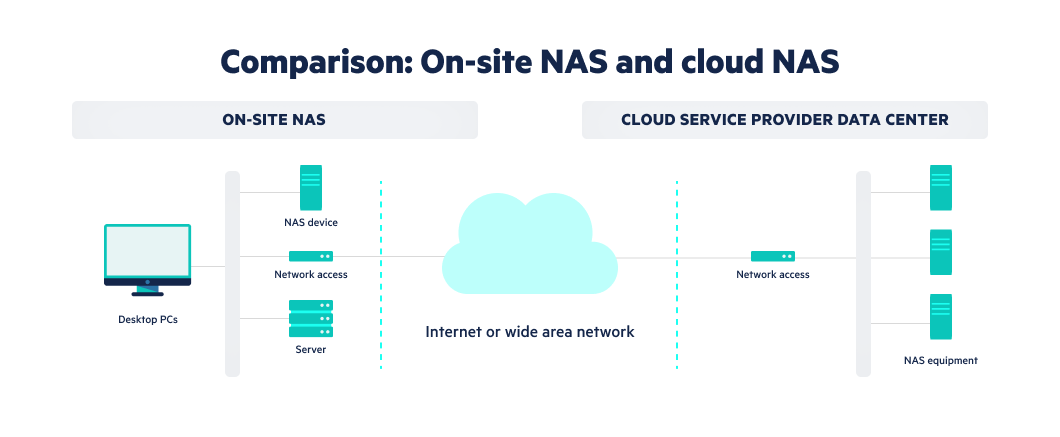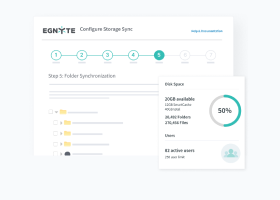Network Attached Storage (NAS) vs. Cloud File Sharing
What Is Network-Attached Storage?
Network-attached storage (NAS) is a storage device dedicated to file storage that makes data available to multiple authorized users or systems from any device. NAS helps users to access, share, and collaborate over a network effectively. These systems provide fast, secure, and reliable storage services to private networks and usually handle unstructured data, such as audio, video, websites, text files, and documents (e.g., spreadsheets, presentations).
NAS devices are specialized servers configured and optimized for data storage and file-sharing requests. Some NAS products are designed for use in large enterprises. Others are for home offices or small businesses.

Most NAS devices are configured and managed with a browser-based utility and do not have a keyboard or display. Each NAS server resides on the network as an independent node and is defined by a unique IP address. NAS connects to a wireless router making it easy for users to access files from any desktop or mobile device with a network connection.
Before the availability of NAS, enterprises had to configure and manage hundreds or even thousands of file servers to meet storage requirements. NAS consolidates storage, but can expand storage capacity by using more and/or larger disks. NAS devices usually contain a minimum of two drive bays, although single-bay systems are available for noncritical data. In enterprise environments, NAS devices have three to five, and sometimes more, drive bays. NAS devices can also be clustered together for scale-out storage to support heavy workloads.
Several ways that NAS is used in enterprise environments include:
- Backup target, using a NAS array for disaster recovery
- Creating active data archives
- File storage and sharing
- Hosting messaging, server-based, open-source applications, and virtual desktop infrastructure
- Serving email, multimedia files, databases, and print jobs
- Storing images and videos that require frequent access
- Streaming media files and torrents
- Testing and developing web-based and server-side web applications
NAS Features, Benefits, and Drawbacks
Features and Benefits of NAS Devices
Control over security
With NAS, all aspects of security are handled in-house. Assuming proper security protocols are followed, this can mean a higher level of security than with a cloud provider.
Cost
While NAS requires an upfront investment, no more expenditure is needed beyond maintenance and repair.
Scale-out capability
NAS can quickly and easily scale out to meet increased capacity demands. This can be done in several ways, including adding a new hard disk or solid-state media, adding a new shelf of drives, or adding a whole new NAS system and coupling it with the installed NAS devices using coupling software.
Size and mobility
Most NAS devices are about the size of a toaster, making them easy to store—at users’ workstations or storage rooms. This makes them easily accessible for maintenance or repairs. And, since they are so small, they are easy to transport if they need to be brought to a service provider for repair.
Advantages of NAS at a Glance
- 24/7 and remote data availability
- Automatic backup to other devices and the cloud
- Failure-tolerant storage volumes
- Easy to install and configure
- Easy to manage
- Multi-protocol support
- Relatively inexpensive
- Self-contained solution
- Universal client access
- Wide array of systems and sizes available
Drawbacks of NAS Devices
Data backups
Because data stored on a NAS device is backed up on-premises, if the NAS device breaks down, is stolen, or is destroyed (e.g., in a fire), the stored files could be lost.
Inadequate resilience
Simple NAS stores data on a remote disk, but if data availability and protection from data loss in the event of a disk failure are requirements, it will not suffice.
Limited failover capacity
Cloud deployments consist of thousands of servers, which can be used for failover. NAS deployments have far fewer available.
Maintenance
Unlike cloud services, maintenance and repairs must be handled directly, which requires IT expertise.
Performance limitations
NAS devices must serve multiple client systems across a network, including users and other applications. I/O contention can occur when too many users access the system at the same time with requests. The resulting inadequate performance can create latency and poor user experiences.
Setup and configuration
NAS requires the setup and configuration of hardware and software, and the device needs to be connected to the network.
Limitations of NAS at a Glance
- Additional input-output processing
- Data lag, missing data, and lost data
- Difficult to scale quickly
- File oriented
- Inability to deliver performance at scale.
- Increased LAN traffic
- Latency for video or multiple large files
- Limited scalability
- Management complexity
- No service guarantees
- Operational burden and drain IT budgets and resources
- Performance depends on the protocol
- Requires knowledge of computer networking
- System available features depend upon the NAS chip and firmware
What Is Cloud NAS?
A cloud NAS works like the legacy, on-premises NAS, but it is a virtual appliance designed to work with and leverage cloud-based storage. It uses cloud computing to provide expandable storage as a central source for storage while still providing enterprise NAS features, such as file access, sharing, and collaboration.
With cloud NAS, a user or business can easily store and access data from cloud storage with the same ease and convenience as a local NAS device in the data center or desktop. Cloud NAS is commonly used for web serving, content management, data analytics, data backups, archiving, streaming content, and software development. In addition, the provider supports key storage capabilities with cloud NAS, such as high availability, performance, security, and comprehensive management and maintenance.
NAS is on-premises or in a data center and connects to a local network. A cloud NAS works similarly to on-premises NAS devices, but is stored in the cloud and supported by third-party providers.

The benefits of cloud NAS include:
- Access to data from anywhere
- Cost-effective, because pay for services used
- Flexible deployment options
- No additional floor space required
- Reduced overhead and operations expenses
- Scalable
- Simplified infrastructure
- Useful for disaster recovery
How to Choose the Best Option for Your Organization
When considering options for your organization, it is essential to understand current and potential future requirements. A few details to look into when evaluating options include the following.
- Is there a charge for hosting as well as the interface?
- What support is available?
- Are there any limits on storage capacity?
- Is enterprise-class high availability offered?
- What extensions are available, such as:
- Migration of data from on-premise to cloud
- Options to move cold data from high-performance storage to lower-grade storage
- Data orchestration to automate the movement and transformation of data
- Do you want data stored by a third party or on-premises?
- How safe is data once it is accessible online?
- What security systems and processes are used to protect data?
- How complex is setup and configuration for on-premises systems?
- How are backup and recovery handled?
- What are the performance requirements and each solution’s capabilities?
- What are the costs associated with each solution?
- How is data resilience ensured?
Take Time to Understand Your File-Sharing and Storage Options
The growing demand for file-sharing and storage solutions has increased the options available for on-premises NAS devices and cloud solutions. However, there are pros and cons to each option. Organizations sometimes use a combination of NAS and cloud file-sharing and storage options. Regardless of the selected approach, take time to understand the capabilities, especially regarding security and resilience.
Egnyte has experts ready to answer your questions. For more than a decade, Egnyte has helped more than 16,000 customers with millions of customers worldwide.
Last Updated: 6th March, 2023



